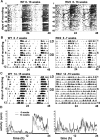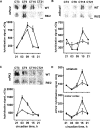Disintegration of the sleep-wake cycle and circadian timing in Huntington's disease
- PMID: 15634777
- PMCID: PMC6725210
- DOI: 10.1523/JNEUROSCI.3842-04.2005
Disintegration of the sleep-wake cycle and circadian timing in Huntington's disease
Erratum in
- J Neurosci. 2005 Apr 13;25(15):3994
Abstract
Sleep disturbances in neurological disorders have a devastating impact on patient and carer alike. However, their pathological origin is unknown. Here we show that patients with Huntington's disease (HD) have disrupted night-day activity patterns. This disruption was mirrored in a transgenic model of HD (R6/2 mice) in which daytime activity increased and nocturnal activity fell, eventually leading to the complete disintegration of circadian behavior. The behavioral disturbance was accompanied by marked disruption of expression of the circadian clock genes mPer2 and mBmal1 in the suprachiasmatic nuclei (SCN), the principal circadian pacemaker in the brain. The circadian peak of expression of mPer2 was prematurely truncated, and the mRNA levels of mBmal1 were attenuated and failed to exhibit a significant circadian oscillation. Circadian cycles of gene expression in the motor cortex and striatum, markers of behavioral activation in wild-type mice, were also suppressed in the R6/2 mice, providing a neural correlate of the disturbed activity cycles. Increased daytime activity was also associated with reduced SCN expression of prokineticin 2, a transcriptional target of mBmal1 encoding a neuropeptide that normally suppresses daytime activity in nocturnal mammals. Together, these molecular abnormalities could explain the pathophysiological changes in circadian behavior. We propose that circadian sleep disturbances are an important pathological feature of HD, that they arise from pathology within the SCN molecular oscillation, and that their treatment will bring appreciable benefits to HD patients.
Figures




References
-
- Akhtar RA, Reddy AB, Maywood ES, Clayton JD, King VM, Smith AG, Gant TW, Hastings MH, Kyriacou CP (2002) Circadian cycling of the mouse liver transcriptome, as revealed by cDNA microarray, is driven by the suprachiasmatic nucleus. Curr Biol 12: 540-550. - PubMed
-
- Askenasy JJ (2001) Approaching disturbed sleep in late Parkinson's disease: first step toward a proposal for a revised UPDRS. Parkinsonism Relat Disord 8: 123-131. - PubMed
-
- Bates GP, Harper PS, Jones L, eds (2002) Huntington's disease, Ed 3. Oxford: Oxford UP.
-
- Bianchetti A, Scuratti A, Zanetti O, Binetti G, Frisoni GB, Magni E, Trabucchi M (1995) Predictors of mortality and institutionalization in Alzheimer disease patients 1 year after discharge from an Alzheimer dementia unit. Dementia 6: 108-112. - PubMed
Publication types
MeSH terms
LinkOut - more resources
Full Text Sources
Medical
Molecular Biology Databases
